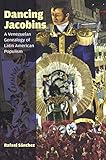Dancing Jacobins : A Venezuelan Genealogy of Latin American Populism / Rafael Sánchez.
Material type: TextPublisher: New York, NY : Fordham University Press, [2016]Copyright date: ©2016Description: 1 online resource (408 p.)Content type:
TextPublisher: New York, NY : Fordham University Press, [2016]Copyright date: ©2016Description: 1 online resource (408 p.)Content type: - 9780823263660
- 9780823263684
- Crowds -- Political aspects -- Venezuela -- History
- Political culture -- Venezuela -- History
- Politicians -- Venezuela -- History
- Populism -- Latin America -- History
- Populism -- Venezuela -- History
- Presidents -- Venezuela -- Biography
- Public relations and politics -- Venezuela -- History
- Anthropology
- Latin American Studies
- Political Science
- SOCIAL SCIENCE / Anthropology / Cultural & Social
- 987.06/42092 23
- F2329 .S257 2016eb
- online - DeGruyter
- Issued also in print.
| Item type | Current library | Call number | URL | Status | Notes | Barcode | |
|---|---|---|---|---|---|---|---|
 eBook
eBook
|
Biblioteca "Angelicum" Pont. Univ. S.Tommaso d'Aquino Nuvola online | online - DeGruyter (Browse shelf(Opens below)) | Online access | Not for loan (Accesso limitato) | Accesso per gli utenti autorizzati / Access for authorized users | (dgr)9780823263684 |
Frontmatter -- Contents -- Figures -- Introduction. Populist Governmentality -- Overture -- Chapter 1. Archaeologies -- Chapter 2. Bullying for Independence -- Chapter 3. Statues and Statutes -- Chapter 4. Theater for the Masses -- Chapter 5. Monumental Governmentality -- Interlude: Dancing Jacobins -- Chapter 6. The French Repertoire -- Chapter 7. Scenes of the Imaginary, I -- Chapter 8. Scenes of the Imaginary, II -- Chapter 9. The (Bolívarian) People Is in the Army -- Chapter 10. "In My Image and Likeness" -- Epilogue. Dancing and the Return of the Crowds -- Acknowledgments -- Notes -- Works Cited -- Index
restricted access online access with authorization star
http://purl.org/coar/access_right/c_16ec
Since independence from Spain, a trope has remained pervasive in Latin America's republican imaginary: that of an endless antagonism pitting civilization against barbarism as irreconcilable poles within which a nation's life unfolds. This book apprehends that trope not just as the phantasmatic projection of postcolonial elites fearful of the popular sectors but also as a symptom of a stubborn historical predicament: the cyclical insistence with which the subaltern populations menacingly return to the nation's public spaces in the form of crowds.Focused on Venezuela but relevant to the rest of Latin America, and drawing on a rich theoretical literature including authors like Derrida, Foucault, Lacoue-Labarthe, Nancy, Lyotard, Laclau, Taussig, and others, Dancing Jacobins is a genealogical investigation of the intrinsically populist "monumental governmentality" that in response to this predicament began to take shape in that nation at the time of independence. Informed by a Bolivarian political theology, the nation's representatives, or "dancing Jacobins," recursively draw on the repertoire of busts, portraits, and equestrian statues of national heroes scattered across Venezuela in a montage of monuments and dancing-or universal and particular. They monumentalize themselves on the stage of the polity as a ponderously statuesque yet occasionally riotous reflection of the nation's general will.To this day, the nervous oscillation between crowds and peoplehood intrinsic to this form of government has inflected the republic's institutions and constructs, from the sovereign "people" to the nation's heroic imaginary, its constitutional texts, representative figures, parliamentary structures, and, not least, its army. Through this movement of collection and dispersion, these institutions are at all times haunted and imbued from within by the crowds they otherwise set out to mold, enframe, and address.
Issued also in print.
Mode of access: Internet via World Wide Web.
In English.
Description based on online resource; title from PDF title page (publisher's Web site, viewed 02. Mrz 2022)


